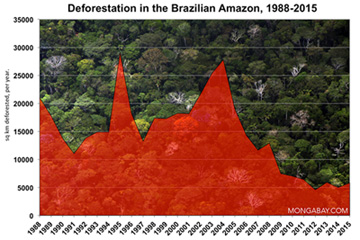WWF knocks Brazil’s plan to cut Amazon deforestation
mongabay.com
December 4, 2008
|
|
WWF criticized Brazil’s plan to reduce Amazon deforestation to 5,740 square kilometers per year as being “short on ambition and detail”.
In a statement issued Wednesday, WWF said that Brazil’s proposed fund for conserving the Amazon would still result in the annual loss of an area forest the size of Rhode Island.
“The CO2 released from clearing this area of Amazon forest would be roughly equivalent to the current annual emissions of Canada,” said Carlos Alberto de Mattos Scaramuzza, Conservation Director at WWF-Brazil.
The group called for more details on how the funds would be used to prevent deforestation and said Brazil should aim for more aggressive reductions in forest clearing: net deforestation of zero by 2015.
“This goal is achievable if key actors—ranging from indigenous peoples to ranchers—are compensated for conserving the forest and thereby avoiding deforestation,” Scaramuzza said.
 |
“This fund appears to be geared primarily to supporting government command-and-control programmes,” added WWF-Brazil’s CEO Denise Hamú. “To achieve more ambitious reductions in deforestation, it will be effective mechanisms to compensate the key actors on the ground who determine the fate of the forest.”
Brazil has proposed raising $21 billion in voluntary contributions from developed countries and corporations for its “Amazon Fund.” Norway has already committed up to one billion dollars by 2015 provided Brazil meets its targets for reducing deforestation.
Brazil would like to see its proposal be used for a global model to reduce emissions from deforestation and forest degradation. Under the design, payments from industrialized nations would into a pool which is then distributed to countries that demonstrate reductions in deforestation. The proposal includes two categories — countries that are ready to start and countries that need funding for capacity building. Resources for capacity building would come from institutions like the World Bank and voluntary donors in developed countries. Developed countries would not be eligible for conventional carbon credits under the arrangement. Instead they would be afforded with non-tradable “certificates”.
WWF and forest carbon
WWF recently changed its position on Reducing Emissions from Deforestation and forest Degradation (REDD), a proposed mechanism for fighting climate. Until last year, the group had opposed the concept on the grounds that it would undermine the carbon market and give polluters an easy way to avoid reducing industrial emissions. WWF’s support for the inclusion of forest carbon under an international framework on climate was officially unveiled by WWF president and CEO Carter Roberts at an “avoided deforestation” meeting in New York this past September.
“The Amazon, if it were a country, would be in the top seven emitters of greenhouse gases in the world,” Carter said. “Unless the world has policies that recognize that value of standing trees and forests, we will have failed.”
“In Kyoto, WWF was pivotal in keeping forests out. We have changed our position.”
Related articles
Brazil to cut Amazon deforestation by 70% to fight global warming
(12/01/2008) Brazil will aim to cut its deforestation rate to 5,742 square kilometers (2,200 square miles) per year by 2018 under its plan to reduce emissions from forest clearing, said Environment Minister Carlos Minc. For comparison, forest loss for the August 2007-July 2008 period was 11,968 square kilometers (4,621 square miles). The plan will be financed by the country’s Amazon Fund which relies on voluntary contributions from governments, corporations, and wealthy individuals. Norway has pledged up to a billion dollars to the fund depending on Brazil’s effectiveness in reducing deforestation. Contributors are not eligible for carbon credits.
Amazon deforestation rises slightly to 4,600 square miles in 2008
(11/28/2008) Deforestation in the Brazilian Amazon increased slightly for the August 2007-July 2008 period, reports the country’s National Institute of Space Research (INPE). The rise is the first since 2004 when 27,379 square kilometers were destroyed, but is lower than forecast. The 2008 figure is the second-lowest annual loss since 1991.
Future threats to the Amazon rainforest
(7/31/2008) Between June 2000 and June 2008, more than 150,000 square kilometers of rainforest were cleared in the Brazilian Amazon. While deforestation rates have slowed since 2004, forest loss is expected to continue for the foreseeable future. This is a look at past, current and potential future drivers of deforestation in the Brazilian Amazon.